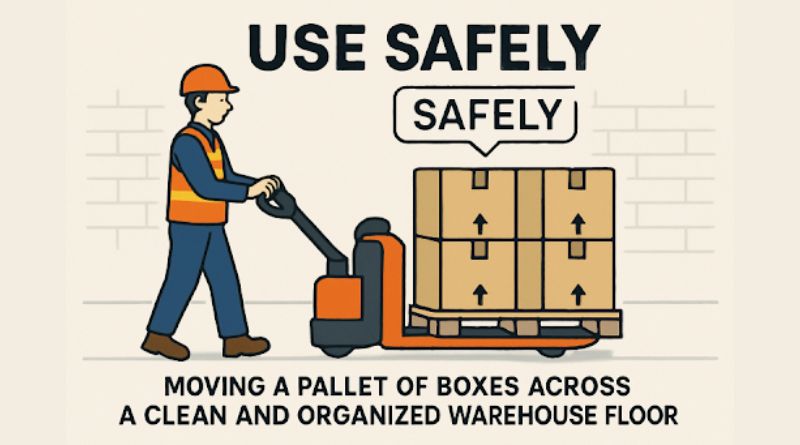In today’s fast-paced warehousing environment, electric pallet jacks have become a go-to solution for enhancing productivity and safety. These powered machines, also called “walkies,” streamline the process of moving pallets and heavy goods, making them invaluable for reducing manual labor and ensuring smoother logistical workflows. For businesses with unique needs, investing in custom material handling equipment is also a smart way to tailor solutions for specific operational requirements.
Technological advances have made electric pallet jacks more reliable and user-friendly, helping warehouses evolve to meet higher demands for order speed, accuracy, and safety. These machines have quickly replaced manual jacks in environments that prioritize scalability and ergonomics, enabling employees to complete their tasks efficiently with minimal risk. Their growing popularity is driven both by necessity and the desire to maintain a competitive edge in the logistics industry.
Another driving factor in adoption is an increasing focus on environmental responsibility, as electric pallet jacks offer an eco-friendly alternative to traditional gas-powered equipment. Warehouses are also responding to stricter safety regulations and higher expectations for worker comfort, all of which are addressed by the latest designs in electric pallet jack technology.
As these tools become mainstream, knowing how to maximize their use is crucial for achieving operational goals. Teams, supervisors, and decision-makers must understand best practices, safety protocols, and maintenance routines that ensure these machines operate safely and efficiently.
Benefits of Electric Pallet Jacks
Electric pallet jacks bring measurable advantages to warehouse operations compared to manual versions:
- Increased Load Capacity: With the ability to handle up to 6,000 pounds, electric jacks significantly boost the movement of goods without overstraining workers, ensuring a more efficient workflow.
- Improved Safety Features: Modern electric models are equipped with features like emergency stop buttons and anti-tip technology, reducing the risk of accidents and making them safer for busy environments where multiple operations occur simultaneously.
- Eco-Friendly Operation: Unlike gas-powered alternatives, electric pallet jacks produce zero on-site emissions, helping warehouses meet environmental goals and comply with sustainability standards.
Key Safety Features
Safety remains a top priority in warehouse equipment design, and electric pallet jacks deliver several essential protections:
- Anti-Rollback Systems: Hold the jack steady when working on inclines to prevent potentially dangerous slips or uncontrolled movement.
- Automatic Braking: The brakes engage instantly when the controls are released, allowing operators to quickly halt the equipment if needed.
- Load Sensors: These intelligent systems alert operators when loads are uneven or exceed the recommended capacity, thereby reducing the risk of accidents due to tipping or overloading.
Such safety measures not only protect workers but also contribute to preserving goods and avoiding damage to valuable inventory.
Operator Training and Safety Guidelines
Comprehensive training is vital to ensure the safe and productive use of electric pallet jacks:
- Understanding Load Capacity:Operators should always respect the manufacturer’s specified load limits, as overloading can compromise safety and lead to costly breakdowns.
- Proper Load Positioning: Keeping loads centered and well-balanced minimizes the risk of tipping and ensures smooth transport across the warehouse floor.
- Awareness of Surroundings: It’s important to scan for obstacles, other workers, and changes in flooring to prevent collisions or mishaps. Awareness is also essential for maintaining an efficient workflow.
Warehouses should reinforce these best practices through regular refresher training and clear signage in key operational areas. The Occupational Safety and Health Administration (OSHA) provides useful guidelines on powered industrial truck safety, which are recommended reading for all warehouse workplaces.
Battery Management and Maintenance
Regular battery care maximizes performance and prolongs the life of your equipment:
- Regular Charging: For optimal output and longevity, batteries should be fully recharged between shifts, not just topped off.
- Maintenance Checks: Routine inspections help catch issues, such as corrosion or loose connections, before they interrupt operations.
- Utilizing Lithium-Ion Batteries:Lithium-ion technology offers extended runtime and faster charging, thereby reducing downtime and enhancing productivity. Source
Following these maintenance steps reduces unplanned breakdowns and ensures electric pallet jacks remain a reliable component of your warehouse fleet. For further maintenance advice, consult Safety+Health Magazine for published tips on safe battery handling and inspection.
Ergonomics and Operator Comfort
Modern electric pallet jacks are thoughtfully engineered for operator comfort, contributing to productivity and employee well-being:
- Adjustable Handles: Handles can be set at various heights, adapting to different operators and reducing wrist and back strain.
- Intuitive Controls: User-friendly button and lever layouts make the operation more accessible, even to new staff.
- Cushioned Platforms: Standing platforms help reduce foot fatigue, particularly in environments with long shifts or extended distances to cover.
Prioritizing ergonomics also lessens injury risk and supports retention by enabling operators to perform their tasks comfortably throughout the day.
Integrating Technology for Enhanced Efficiency
Advanced technology continues to expand the value and capability of electric pallet jacks:
- Automated Systems: Integrating electric pallet jacks with warehouse management software allows for coordinated operation and effective workflow scheduling.
- Real-Time Tracking: Telematics and IoT sensors provide live updates on equipment and inventory, improving response times and asset utilization.
- Data-Driven Metrics: Analytics allow managers to review usage patterns, optimize resource deployment, and minimize downtime.
By embracing these innovations, warehouses can deliver greater efficiency, lower operational costs, and meet the rapidly evolving demands of modern supply chains. For an in-depth look at tech innovations in warehousing, The Wall Street Journal provides a comprehensive overview of recent trends in warehouse automation.
Conclusion
Electric pallet jacks are a cornerstone technology for efficient, safe, and sustainable warehouse management. Leveraging their capacity, safety features, and technological advancements allows warehouses to stay competitive while prioritizing employee well-being. When paired with proper training and regular maintenance, these machines not only support day-to-day operations but also drive long-term growth and flexibility in a continually evolving industry.

